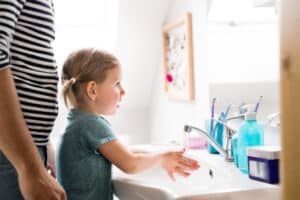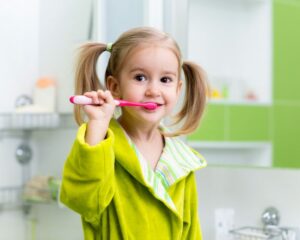Teaching a child proper hygiene is an important life skill that promotes their health, cleanliness, and well-being. But what is the best way to do this so that it sticks with your young kids?
Here are some strategies to help you teach your child proper hygiene:
- Lead By Example
Children often learn by observing and imitating their parents or caregivers. Model good hygiene practices in your daily routine, such as washing your hands, brushing your teeth, and maintaining personal cleanliness. Your consistent demonstration of good hygiene will reinforce the importance of these habits to your child.
- Make It Fun and Interactive
Turn hygiene routines into enjoyable activities. Sing songs, create a handwashing routine with a favorite tune, or use colorful soaps and toothbrushes to make brushing teeth and washing hands more exciting. Incorporate storytelling or playacting to make hygiene practices engaging and memorable.
- Explain the “Why”
Help your child understand the reasons behind proper hygiene. Explain that practicing good hygiene helps prevent illness, keeps their bodies clean, and promotes overall health. Use age-appropriate language and visuals to explain concepts like germs, bacteria, and how they can make us sick.

- Break it Down
Teach hygiene habits in manageable steps. For example, break down handwashing into specific steps: wet hands, apply soap, scrub for 20 seconds, rinse thoroughly, and dry with a clean towel. By breaking down tasks, it becomes easier for children to understand and remember the process.
- Establish Routines
Create consistent routines around hygiene practices. Set specific times for brushing teeth, washing hands before meals and after using the bathroom, bathing, and other hygiene-related activities. Routines provide structure and help children develop good habits.
- Use Visual Aids
Visual aids, such as charts or posters, can serve as reminders and guides for proper hygiene practices. Create or find age-appropriate visuals that illustrate the steps involved in various hygiene routines. Place them in areas like the bathroom to reinforce the habits visually.
- Provide Child-Friendly Tools and Products
Use child-friendly tools and products that are designed to appeal to children. This can include toothbrushes with their favorite characters, flavored toothpaste, colorful soaps, or fun-shaped bath sponges. Choosing items that children find appealing can make hygiene routines more enjoyable.
- Encourage Independence
Gradually encourage your child to take responsibility for their own hygiene. Offer guidance and supervision initially, and then gradually give them more independence to complete tasks like brushing their teeth or washing their hands. Praise their efforts and progress as they develop independent hygiene habits.
- Reinforce Positive Behavior
Provide positive reinforcement when your child practices good hygiene. Offer verbal praise, high-fives, or small rewards to motivate and reinforce their efforts. Celebrate milestones and achievements to encourage them to continue practicing good hygiene.
- Make It a Family Affair
Involve the whole family in practicing good hygiene. Make hygiene routines a shared activity, such as brushing teeth together or having a family handwashing challenge. This creates a supportive and inclusive environment that reinforces the importance of hygiene for everyone.
Remember, teaching proper hygiene is an ongoing process. Be patient and understanding as your child develops and refines their hygiene habits. With consistent guidance, positive reinforcement, and a fun and engaging approach, you can help your child establish lifelong habits of proper hygiene.
